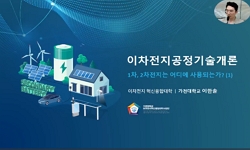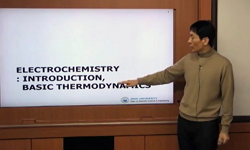Recently, as demand for Electric Car has been increasing, it has been a main factor that maximizing performance and ensuring the stability of the Electric Car battery to increase the reliability of Electric Car. Above all the study on thermal contro...
http://chineseinput.net/에서 pinyin(병음)방식으로 중국어를 변환할 수 있습니다.
변환된 중국어를 복사하여 사용하시면 됩니다.
- 中文 을 입력하시려면 zhongwen을 입력하시고 space를누르시면됩니다.
- 北京 을 입력하시려면 beijing을 입력하시고 space를 누르시면 됩니다.
https://www.riss.kr/link?id=A102496331
- 저자
- 발행기관
- 학술지명
- 권호사항
-
발행연도
2016
-
작성언어
Korean
- 주제어
-
등재정보
KCI등재
-
자료형태
학술저널
-
수록면
879-885(7쪽)
-
KCI 피인용횟수
1
- DOI식별코드
- 제공처
- 소장기관
-
0
상세조회 -
0
다운로드
부가정보
다국어 초록 (Multilingual Abstract)
Recently, as demand for Electric Car has been increasing, it has been a main factor that maximizing performance and ensuring the stability of the Electric Car battery to increase the reliability of Electric Car. Above all the study on thermal control in a big influence on the performance and battery life is growing in parallel. This study has compared cooling effect of an Electric Car battery between battery with Heat Sink and without Heat Sink for optimum design of Electric Car battery. Battery is simply modeled into four cells, divided into two cases of battery with Heat Sink that attached on the cell's side and without Heat Sink. And this research was conducted on forced convection. The battery which is designed by this way was numerically analyzed by CFX 14.5. Numerical results, revealed that the battery with Heat Sink was superior in terms of cooling effect. According to the numerical analysis by battery cell's temperature variations, the battery with Heat Sink turned out to be superior in cooling effect to the battery without Heat Sink.
목차 (Table of Contents)
- ABSTRACT
- 1. 서론
- 2. 설계 및 수치해석
- 2.1 해석 조건
- 2.2 격자 생성
- ABSTRACT
- 1. 서론
- 2. 설계 및 수치해석
- 2.1 해석 조건
- 2.2 격자 생성
- 3. 결과 및 고찰
- 3.1 속도 분포
- 3.2 온도 분포
- 4. 결론
- References
참고문헌 (Reference)
1 서현규, "전기자동차용 배터리 팩 입구 형상에 따른 냉각 성능" 한국기계기술학회 15 (15): 679-684, 2013
2 류의환, "냉각유체 유량에 따른 배터리 모듈의 온도분포 분석" 한국기계기술학회 15 (15): 241-246, 2013
3 류의환, "xEV용 배터리 모듈의 냉각유체 유입구위치에 따른 냉각성능 분석" 한국기계기술학회 15 (15): 967-972, 2013
4 Park, C. W., "Study on the Flow Analysis in the Lithium Polymer Battery with Forced Convection" 407-411, 2015
5 Kim, K. H., "Study on Cooling Effect of Secondary Battery by Forced Convection" 334-338, 2015
6 Jang, J. C., "Electric Automotive Battery Cooling System with Heat pipe" 2596 (2596): 2596-2600, 2010
7 Jung. J. H, "Cooling Characteristics of HEV Battery with Different Lay-Outs" 13 : 743-747, 2012
8 Jang, I. H., "Analysis of Cooling Efficiency depending on gap of Battery Packs" 1825-1829, 2009
1 서현규, "전기자동차용 배터리 팩 입구 형상에 따른 냉각 성능" 한국기계기술학회 15 (15): 679-684, 2013
2 류의환, "냉각유체 유량에 따른 배터리 모듈의 온도분포 분석" 한국기계기술학회 15 (15): 241-246, 2013
3 류의환, "xEV용 배터리 모듈의 냉각유체 유입구위치에 따른 냉각성능 분석" 한국기계기술학회 15 (15): 967-972, 2013
4 Park, C. W., "Study on the Flow Analysis in the Lithium Polymer Battery with Forced Convection" 407-411, 2015
5 Kim, K. H., "Study on Cooling Effect of Secondary Battery by Forced Convection" 334-338, 2015
6 Jang, J. C., "Electric Automotive Battery Cooling System with Heat pipe" 2596 (2596): 2596-2600, 2010
7 Jung. J. H, "Cooling Characteristics of HEV Battery with Different Lay-Outs" 13 : 743-747, 2012
8 Jang, I. H., "Analysis of Cooling Efficiency depending on gap of Battery Packs" 1825-1829, 2009
동일학술지(권/호) 다른 논문
-
- 한국기계기술학회
- 원대희
- 2016
- KCI등재
-
- 한국기계기술학회
- 정현석
- 2016
- KCI등재
-
승용 A-IMS 모듈의 토크 변경에 따른 응력 분포특성
- 한국기계기술학회
- 민세훈
- 2016
- KCI등재
-
- 한국기계기술학회
- 김종석
- 2016
- KCI등재
분석정보
인용정보 인용지수 설명보기
학술지 이력
| 연월일 | 이력구분 | 이력상세 | 등재구분 |
|---|---|---|---|
| 2026 | 평가예정 | 재인증평가 신청대상 (재인증) | |
| 2020-01-01 | 평가 | 등재학술지 유지 (재인증) |  |
| 2017-01-01 | 평가 | 등재학술지 유지 (계속평가) |  |
| 2015-04-01 | 학회명변경 | 영문명 : Journal of the Korean Society of Mechanical Technology -> Korean Society of Mechanical Technology |  |
| 2014-01-01 | 평가 | 등재학술지 선정 (계속평가) |  |
| 2013-01-01 | 평가 | 등재후보 1차 PASS (등재후보1차) |  |
| 2012-01-01 | 평가 | 등재후보학술지 유지 (기타) |  |
| 2011-01-01 | 평가 | 등재후보 1차 FAIL (등재후보2차) |  |
| 2010-01-01 | 평가 | 등재후보 1차 PASS (등재후보1차) |  |
| 2008-01-01 | 평가 | 등재후보학술지 선정 (신규평가) |  |
학술지 인용정보
| 기준연도 | WOS-KCI 통합IF(2년) | KCIF(2년) | KCIF(3년) |
|---|---|---|---|
| 2016 | 0.4 | 0.4 | 0.36 |
| KCIF(4년) | KCIF(5년) | 중심성지수(3년) | 즉시성지수 |
| 0.39 | 0.38 | 0.279 | 0.22 |





 KCI
KCI 코리아스칼라
코리아스칼라







